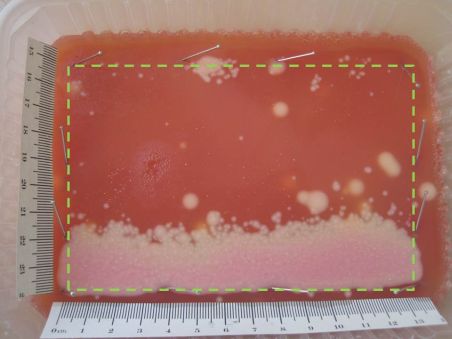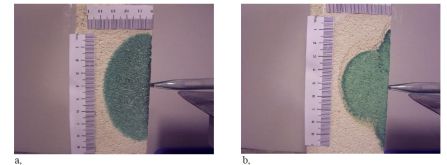 |
BMe Research School |

|
Pál Vásárhelyi Doctorate School of Civil Engineering and Earth Sciences
Department of Construction Materials and Engineering Geology
Supervisor: Dr. Katalin Kopecskó
Effect of biomineralization on porous limestone
Introducing the research area
My doctoral research is done on biomineralization, more precisely on the application of this bio-based calcium-carbonate precipitation for the protection of stone materials and for other construction industry purposes. Biomineralization is a phenomenon, when some bacterial strains secrete carbonate ions to their extracellular space, while digesting specific organic matter. These ions react with the calcium ions added to the micro-environment of bacteria, leading to calcium-cabonate precipitation, which is the component of limestone.
Brief introduction of the research place
My experiments are performed at the Department of Construction Materials and Engineering Geology of the Budapest University of Technology and Economics, Faculty of Civil Engineering. We are also supported in the preparation of certain experiments by the Department of Applied Biotechnology and Food Science of the Faculty of Chemical Technology and Biotechnology.
History and context of the research
The phenomenon of biomineralization, thus microbial calcium-carbonate precipitation was first published in 1973 [1]. Thereafter, French researchers started to elaborate the phenomenon and its possible usage, too. In 1990 they patented a method, whereby bacterial calcium-carbonate precipitation was applied for repair and treatment of porous surfaces [2]. This European patent was preceded by a long research and testing procedure [3], and after the acceptance of the patent a company called Calcite Bioconcept was founded. They have yet treated several French buildings with their own material and method.
Two main trends emerged in the research field of biomineralization: biodeposition and biocementation [4]. Biodeposition has been developed mostly for the protection of porous stone materials, as well as of artificial porous materials like concrete and plaster.
The objective of biocementation is the application of the newly formed bacterial crystals as a binder. These crystals are applied either as an exclusive, or as a supplementary binder.
Moreover, research is performed on the application of biomineralization for the production of self-healing concrete. Bacteria, nutrients and calcium-carbonate sources are mixed together with the concrete. As the cemented matrix cracks, water ingresses into the material, and bacteria, thus the biomineralization process would be activated [4].
The research goal, open questions
During my research, I analyze the mode of action of biomineralization treatments on porous limestone materials, as well as the determination and testing of the further ways of possible application.
The objectives aiming to understand the mode of action are the identification of special experimental and practical characteristics (eg. migration depth and effective depth), understanding the effect of the pore-structure of the porous limestone on the water-absorption, and understanding the flowing characteristics of the curing compound (eg. disintegration of the treating compound).
Regarding the stone material, I analyze the effectiveness of a biomineralizing treatment when applied on a highly porous (above 30% apparent porosity) material. My experiments revealed, that the treatment has the most significant results on the water-absorption properties. My aim is the exact explanation of the changes in the different characteristics due to biomineralization, as well as analysis of the related changes in durability of treatment.
Concerning the application of the treatment in situ, there are few results on the efficacy of repairs of various forms of deteriorations with help of a bio-based treatment. Therefore, I plan to report results from in situ, lifelike experiments, too.
Methods
Evaluation of the effect of biomineralization has to combine experimental methods of microbiology and materials science. My own experiments have been performed on porous limestone of Sóskút with either coarse or middle-sized grains, and by applying different curing compounds inoculated with Bacillus cereus and Myxococcus xanthus bacteria.
In order to determine the effect of the biomineralization, both standardized and newly designed measurements and experiments were performed. Effects were evaluated by comparing the difference in the characteristics of stone material in two states, before and after the treatment.
First, changes of the mass properties, like dry mass, density, porosity were measured [5]. Then, changes of the mechanical properties were evaluated with uni-axial compressive strength test and surface hardness tests using Duroscope. Treated and non-treated groups of limestone cylinders, as well as limestone slabs were used for this purpose [6]. Moreover, cementation of the grains due to the treatment was evaluated with peeling-tape test [7].
Since possible colour changes due to surface treatment is a major issue in stone conservation, these changes were also evaluated with help of histogram-analysis of images taken before and after the treatment [8]. Later, spectrophotometer was applied for quantitative analysis and for the determination of the total color change, ΔE in CIEM-Lab color space.
Water absorption of the limestone was also analyzed, by means of capillary elevation, absorbed mass of water [10] and sorption profile. The latter one was evaluated with help of a newly invented technique, the horizontal sorption. This method both enabled the non-destructive analysis of the orientation of limestone fabric, and - by using colored water - the analysis of migration profile [11].
Migration depth of the curing compound was also analyzed, since it has a direct effect on the effective depth of the biodeposition. For this purpose, the curing compound was applied on the cylindrical specimens through capillary absorption, and the treated specimens were printed on strain-selective agar plates. Distribution of the forming colonies of bacteria on the agar plate gave information on the migration depth [12]. Effective depth of biodeposition was also determined by horizontal sorption test.
Besides the above mentioned tests, restoration-oriented experiments were also performed. They included cementation and fixation of limestone layers and fine grains onto porous limestone surface.
Results
During mass composition tests, dry masses of treated and washed specimens increased with an average of 0,2 m/m %, which is attributed to the small amount (1,25 – 2,40 m/V % ; g/ml ) of solved dry mass of the biomineralizing compounds. This small increase, however, decreased the water-accessible porosity of the stone by 10% [5].
Neither the uni-axial compressive strength test, nor the surface hardness test resulted in significant changes comparing the treated and non-treated specimens [6], [7]. This suggests, that biomineralization is not suitable for strengthening purposes when the treating compound contains only small concentration of the solved material.
Chromatic measurements showed that no significant changes can be expected when transparent or translucent compound is used. Total color difference values ranged from 1.05 to 5.67, of which only one compound had a ΔE value above 5, the recognition threshold. This one can be contributed to the yellowish color of the compound due to its urea-content [8], [9].
Water absorption tests showed decrease in the rate of absorption both by means of the mass of absorbed water (around initial decrease of 30%), and the velocity of capillary elevation [5], [10].
With help of absorption-test, it was shown, that the curing compound will filtrate during the absorption. Printings of the specimens on agar plates showed, that the bacteria can only migrate into a certain depth (14-28 mm) - Fig.1. This phenomenon is notable, since the treating compound elevated to the top of the 90 mm high specimen.By application of different quantities of curing compound it was shown, that migration depth of the bacteria is dependent on the quantity of bacteria in the compound, and independent from the velocity of absorption [11], [12].

Fig.1. Colonies of Bacillus cereus grown inside the contour of the print of the specimen (marked with green broken line)
It was also shown, that presence of non-metabolized organic leftovers in the pores will cause error during a measurement.
With help of horizontal sorption test and analysis of the sorption profile (Fig. 2.), orientation of the fabric of limestone was shown. Moreover, effective depth of biodeposition was demonstrated, and measured to be between 4-5 mm – see Fig. 3.

Fig.2. Development of the sorption profile – profile after 5,11, 24 and 37 minutes

Fig.3. Even profile on non-treated- (a.), and uneven profile on treated specimen (b.)
Our cementing experiments showed, that the organic matter has a good cementing characteristic on its own, but it is terminated in presence of water.
Expected impact, future plans
The most important companies and research centers engaged in the development of biomineralization for construction industry are the Ghent University (stone- and concrete research), a French company (stone conservation) and a German company (self-healing concrete). Out of these, I am consulting and cooperating with the first two, and the third one has expressed interest in my research at a conference.
I have published my results in journals and conference articles in English, and presented at conferences with international participation. My research plan includes durability tests, repair of deteriorated stones, and tests with admixtures.
Own publications, references, links
List of publications
[1] Boquet, E., Boronat, A., Ramos-Cormenzana, A. (1973), Production of calcite (calcium carbonate) crystals by soil bacteria is a common phenomenon. Nature 246, pp. 527–529.
[2] Adolphe, J.-P., Loubie`re, J.-F., Paradas, J., Soleilhavoup, F. (1990), Proce´de´ de traitement biologique d’une surface artificielle. European patent No. 90400G97.0 (after French patent No. 8903517, 1989).
[3] Le Métayer-Levrel, G., S. Castanier, S., G.Orial, J.-F. Loubière, J.-P., Perthuisot (1999), Applications of bacterial carbonatogenesis to the protection and regeneration of limestones in buildings and historic patrimony. Sedimentary Geology 126 (1999) pp. 25-34
[4] De Muynck, W., De Belie, N., Verstraeteb, W. (2010), Microbial carbonate precipitation in construction materials: A review. Ecological Engineering, Vol. (36) pp. 118–136.
Own publications concerning the research
[5] Juhász, P., Kopecskó K. (2012), Consolidation and strengthening effect of biomineralization on porous materials. Concrete Structures 13 (1) pp. 65-71.
[6] Juhász P. (2012), Influence of biomineralization on mechanical and physical characteristics of Hungarian limestone. In: Harald S. Müller, Michael Haist, Fernando Acosta: Proceedings of the 9th fib International PhD Symposium in Civil Engineering, pp. 181-186. Paper 28.
[7] Juhász, P., Kopecskó K. (2013), in press: Evaluating effect of biomineralization compounds on the surface hardness and material loss of porous limestone. Pollack Periodica, referenciaszám: PP-2013-36
[8] Juhász, P. (2012), Analysis of effects of biomineralization on porous limestone. In: Józsa János, Lovas Tamás, Németh Róbert (Ed..) Proceedings of the Conference of Junior Researchers in Civil Engineering 2012. pp. 70-76. Paper 11. ISBN: 978-963-313-061-2
[9] Juhász, P., Kopecskó, K., 2013. Biomineralizáció – alkalmazott mikrobiológia az építőanyag-kutatásban. In: XVII. Nemzetközi Építéstudományi Konferencia: ÉPKO 2013. Csíksomlyó, Románia, 2013.06.13-2013.06.16. Kolozsvár: pp. 154 - 159. ISBN: 1843-2123
[10] Juhász, P., Béla, Sz., Kopecskó, K., 2013. Mathematical analysis of capillary elevation of porous limestone. Építőanyag 65. pp. 2-5.
[11] Juhász, P. Suhajda Á., Kopecskó K., 2013. Analysis of the effective depth of a biominearlizing treatment In: Józsa János, Lovas Tamás, Németh Róbert: Proceedings of the Second Conference of Junior Researchers in Civil Engineering 2013.
[12] Juhász, P., Kopecskó, K., 2013 – accepted Analysis of capillary absorbtion properties of porous limestone material and its relation to the migration depth of bacteria in biomineralizing compound. Periodica Polytechnika
[13] Juhász, P., Kopecskó, K., 2013. – submitted: Introduction of a new technique in observation of newly formed layers and contaminants on stone surfaces. Central European Geology
